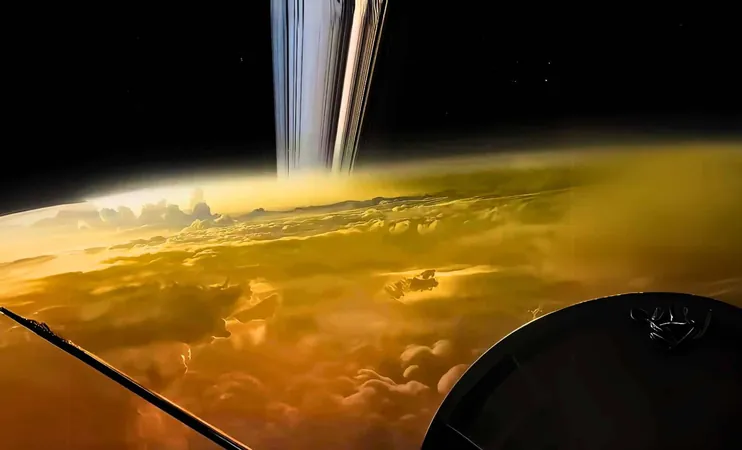
NASA Sets the Record Straight on Viral 'Last Photo' from Cassini's Final Plunge Into Saturn!
2025-03-30
Author: Jia
The Extraordinary Journey of Cassini
The Cassini–Huygens mission, a collaborative effort by NASA and the European Space Agency (ESA), began its epic journey in 1997 and reached Saturn in 2004. For an astonishing 13 years, this groundbreaking spacecraft explored the mysteries of Saturn’s atmosphere, its intricate ring system, and its diverse moons, delivering a wealth of scientific knowledge.
Concluding on September 15, 2017, Cassini's mission was designed with a deliberate endgame: a controlled dive into Saturn's atmosphere, dubbed the "Grand Finale." This maneuver was carefully orchestrated to eliminate any risk of contaminating the potentially habitable moons, such as Titan and Enceladus.
Throughout its farewell, Cassini executed a series of daring orbits, gathering crucial data and sending back invaluable scientific insights.
The Viral Image: Beautiful but Not Authentic
Recently, a TikTok video boasting over 6.4 million views claimed to display Cassini's "last image," described as a colorized monochrome shot captured from a distance of 639,000 kilometers, showcasing sunlight reflecting off Saturn’s icy rings. While mesmerizing, the truth is far less dramatic: this image is a digital rendering, created by NASA’s Jet Propulsion Laboratory (JPL-Caltech), representing an artist's interpretation of what Cassini's descent might have looked like.
Though shared on NASA’s official site, the image was never intended to portray an actual photograph taken during Cassini's demise.
The Real Last Images from Cassini
While the viral image dazzled audiences online, Cassini did, in fact, share real images during its final moments. These included monochrome snapshots of Saturn’s clouds and atmosphere. However, the conditions leading up to its plunge meant that these images were less visually striking yet carried significant scientific value.
Cassini’s final photograph, taken just hours before impact, displayed a nondescript section of Saturn's atmosphere. The mission came to an end when the last signal was received at 7:55 AM EDT on September 15, 2017, officially marking the conclusion of its groundbreaking mission.
Misinformation on Social Media
The rapid dissemination of this misleading image underscores the complexities of science communication in today’s visual and fast-paced digital landscape. Many viewers accepted the video at face value, but others were quick to emphasize the truth.
Comments ranged from, "There is a photo taken by Cassini as it was falling into Saturn. It’s easily found with a quick search. This is NOT the photo," to expressions of wonder such as, "This isn't actually the real image. Still beautiful though."
This contrast between compelling visuals and scientific truth highlights a significant challenge faced by scientists and communicators striving to engage the public in meaningful ways.
Celebrating Cassini's Remarkable Legacy
Despite the mix-up surrounding the viral image, Cassini's legacy remains monumental. Over its nearly two-decade mission, it redefined our understanding of the Saturnian system, revealing fascinating features like methane lakes on Titan and the geysers of Enceladus, as well as unraveling the complex striations of Saturn's rings.
The widespread fascination with Cassini, even years after its mission concluded, is a testament to the inspiring and bewildering nature of space exploration. In a world overflowing with viral content, the truth behind Cassini's descent continues to invoke wonder—reminding us of the beauty and complexity of our universe, even if it was not quite captured as romantically as initially believed.
Indeed, each revelation from the cosmos can be both an inspiration and a challenge to discern fact from artistic interpretation, proving once again that the quest for knowledge is as stimulating as the stars themselves!






 Brasil (PT)
Brasil (PT)
 Canada (EN)
Canada (EN)
 Chile (ES)
Chile (ES)
 Česko (CS)
Česko (CS)
 대한민국 (KO)
대한민국 (KO)
 España (ES)
España (ES)
 France (FR)
France (FR)
 Hong Kong (EN)
Hong Kong (EN)
 Italia (IT)
Italia (IT)
 日本 (JA)
日本 (JA)
 Magyarország (HU)
Magyarország (HU)
 Norge (NO)
Norge (NO)
 Polska (PL)
Polska (PL)
 Schweiz (DE)
Schweiz (DE)
 Singapore (EN)
Singapore (EN)
 Sverige (SV)
Sverige (SV)
 Suomi (FI)
Suomi (FI)
 Türkiye (TR)
Türkiye (TR)
 الإمارات العربية المتحدة (AR)
الإمارات العربية المتحدة (AR)